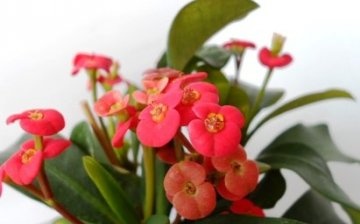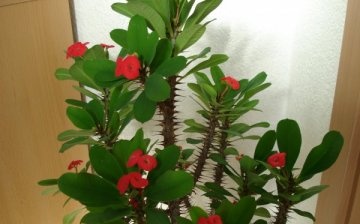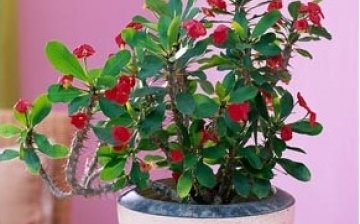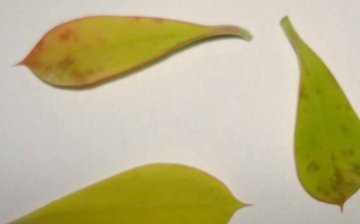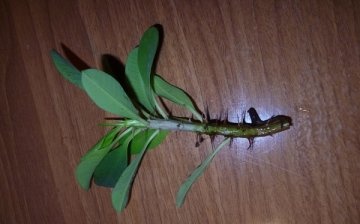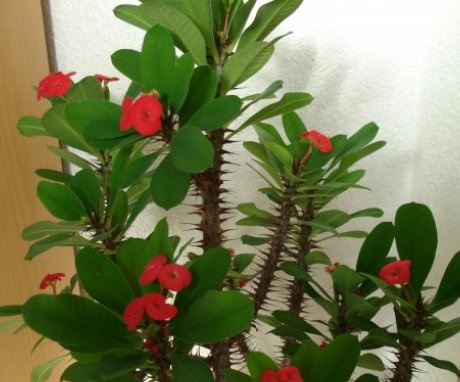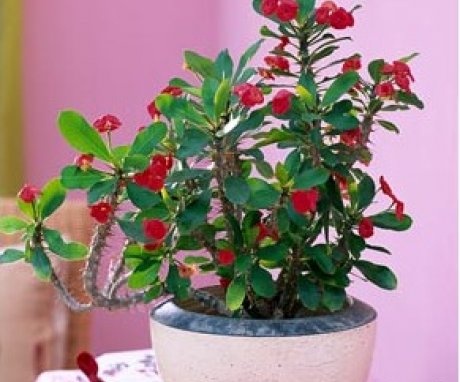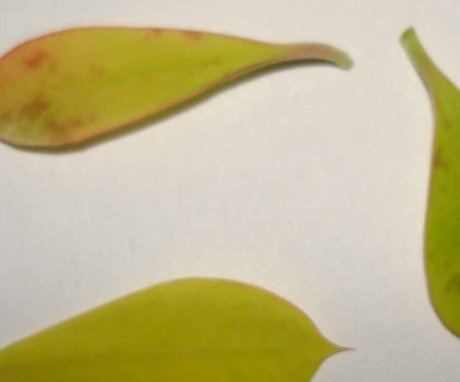Euphorbia Mila: features of care and reproduction
One of them claims that this particular plant is the crown of thorns of Jesus Christ. There are many types of milkweed. One of them was brought in by a baron named Mil at the beginning of the nineteenth century. According to the general opinion of flower growers, Mila spurge is the most beautiful plant species. Therefore, it has long and successfully been bred by flower lovers. In professional greenhouses, it is possible to grow unique specimens of culture. The results on home windowsills look more modest, but in comparison with other cultures it still looks impressive. Let's figure out what we need to properly care for the cultivation of an amazing cactus.
Content:
Milkweed appearance
Euphorbia Mil has other names. It can be found in reference books as a beautiful euphorbia, euphorbia.
The plant was brought to Europe from East Africa and Madagascar. By its nature, spurge - mountain plant.
Characteristic features of the plant:
- The stem of euphorbia is distinguished by an impressive thickness, which sometimes reaches 20 cm. For this reason, the cactus is called columnar. At home, he reaches a large size.
- The leaves are ribbed, have three edges. They end in thorns. The leaves are characterized by rapid fall. On their cut, a poisonous milky juice is released. For this reason, it is recommended to keep the plant away from children. Careless handling of milkweed can cause severe burns or irritation.
- Euphorbia blooms whole year. Oddly enough, the flowers of the milkweed are inconspicuous, small, yellow in color. Where, then, do the beautiful bright pink petals come from? The secret lies in the structure of the leaves. Tiny flowers are collected in goblet inflorescences, at the base of which are covering leaves. It is their bright leaf plates that give the plant a spectacular look.
The peculiarity of milkweed is its slow growth. For a year, the stem of the flower lengthens only a few centimeters.
Another interesting fact is that in natural conditions of growth, the wild culture is very similar in appearance to the American cactus. Similar growing conditions made two different types of cactus twins.
Basic requirements for growing
Milkweed Mil needs thoughtful, intense lighting:
Moreover, it must be provided throughout the year.
- In winter, it can be an artificial lamp.
- The plant loves warmth, which means that the temperature in frost cannot fall below 14 degrees.
- The southern window in the apartment will be ideal conditions for a flower.
- In summer, if possible, pots with a plant can be dropped on the site. The cactus is not afraid of drafts.
Like other cultures of the succulent family, milkweed is required rest period.
Watering should be dosed very carefully:
- So, the flower is watered only in summer. In winter, it is not at all recommended to moisten the soil.
- The water should be soft.
- Although euphorbia is resistant to drought, during the growth period it needs constant maintenance of soil moisture.
- If drying occurs, the plant will shed its leaves, but will not die.
The plant needs fertilizing... The composition is suitable for a mixture for succulents. It should be added after watering. So nutrients penetrate better into the root system and the effect of them is greater. Fertilizers can only be applied in summer.Euphorbia belongs to the bush type, and therefore branches quickly and magnificently.
To form a beautiful shape, you should:
- Split off the tops of young shoots and remove the lateral buds, setting the horizontal direction of growth of the branches. This is done in any season.
- When the spurge reaches its height, the top of the tree is completely cut off.
- The splendor of the crown and the growth rate of milkweed are easily regulated.
- Shoots and buds appear when the light intensity is lowered. If you increase the access of light, then at a temperature of 15 degrees, buds will begin to form.
Euphorbia loves spraying and washing. He is not picky about air humidity.
Here are some common problems associated with growing a flower:
- If the plant begins to fall off or turn yellow in the autumn months, then this is absolutely normal. However, in summer, this may be an indication of a lack of heat.
- If the leaves curl, and the trunk begins to rot, then you should immediately limit watering. A rotten flower usually dies. You can save the upper part by making cuttings from the stems.
- If the leaves turn pale and there is a clear delay in flowering, then the plant needs to add light.
Milkweed pests
Euphorbia can be affected by harmful insects. The most common ones are:
- Spider mite.
- Shield.
- Aphid.
- Whitefly.
First of all you need remove found parasites... Affected leaves and branches will also have to be destroyed. In the fight against pests, special preparations will help.
The most effective ones are:
- Intavir.
- Fufan.
- Derris.
- Actellic.
- Fitoverm.
If the culture is severely damaged, the treatment can be repeated several times.
If euphorbia is affected by fungal diseases, such as mealy root bugs, it is important to treat it with disinfectants. If you do not take action in time, the plant is doomed.
Plant propagation
Euphorbia can be diluted with cuttings or seeds.
Cuttings are rooted in summer or spring:
- The peculiarity of the flower is that before planting young shoots be sure to wash off the milky juice.
- For this, the prepared cuttings are washed with warm water.
- Then they are sprinkled with charcoal on the cut or treated with a rooting agent.
- Shoots are dried before planting for several days.
- Lateral processes are used for dividing.
When propagating by seeds, it is important to remember:
- That the plant does not retain varietal characteristics.
- The seeds are harvested and then planted in damp ground.
- Before the first shoots appear, it is better to protect the plantings with foil or plastic cans. This is done before the first leaves appear.
- Euphorbia is transplanted as needed, when the container becomes cramped.
- It is better to work with a flower with gloves to protect your hands from sharp thorns.
The most suitable composition for a flower:
- Peat.
- Sod.
- Sand.
- Leafy land.
- Brick chips.
- Humus.
It is better to buy soil for cactus from ready-made mixtures. You can use a heavier soil that contains clay.
A mandatory requirement in this case is the construction of a drainage.
Make sure that the pot has a hole at the bottom. A special drainage layer must be laid out on the bottom.
So, Mil's milkweed has no special problems in care or reproduction. Varietal flower variety striking in its beauty. The plant deserves to take its place in the ranks of the cactus collection as well as in mixed compositions composed of other succulents.
More information can be found in the video.



